Part 46
Update 45: Beyond the gates of Paradise.
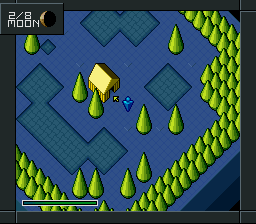
It is EDEN!
Let's speak with the rest of the EDENians.
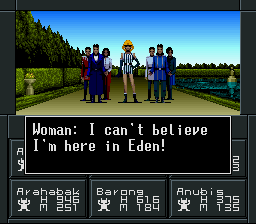
Well. You are. Not going to mache you much good, though.
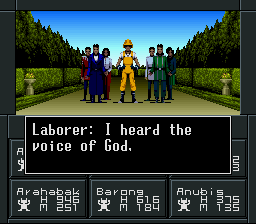
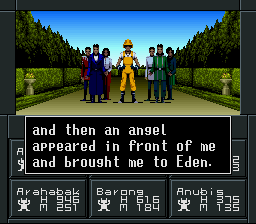

If that's how you want to spend your last moments, that is fine for me.
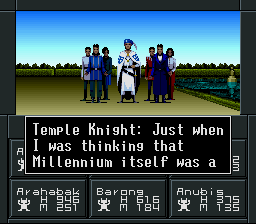
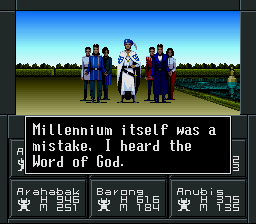
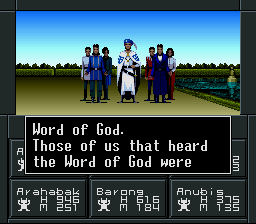
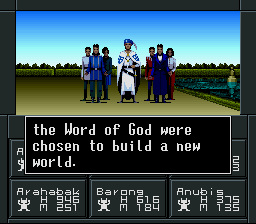
But to do that you must destroy the old world. Again. That cannot be allowed.
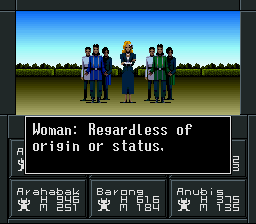
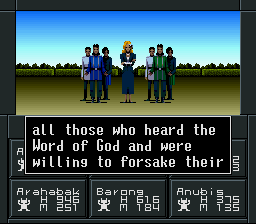
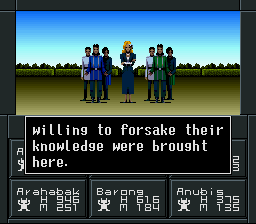
Great, so now they don't know anything.
Or they can't tell good from evil, I don't know.

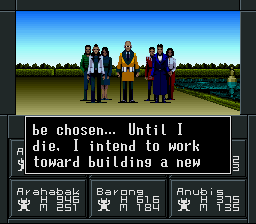
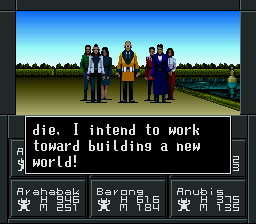
Sure. yeah. Right.
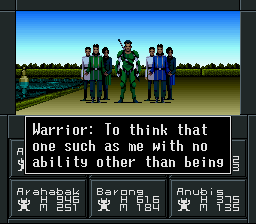
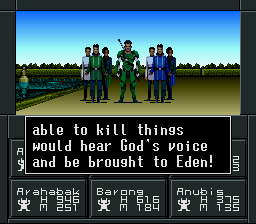
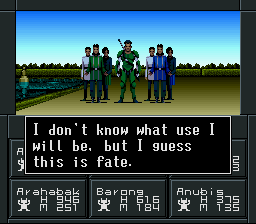
No use at all.
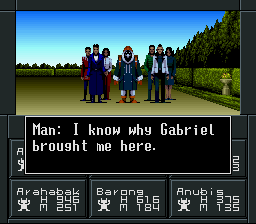
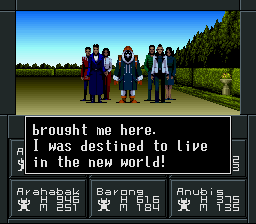
Or to die at Aleph's hands if you oppose him. As Aleph is now neutral death incarnate.
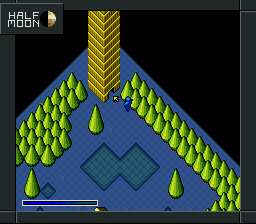
Big building. Something important there, I am sure.
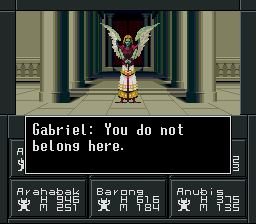
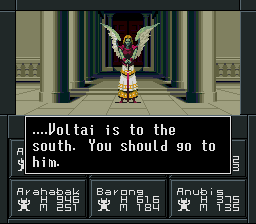
Oh.
Okay.
Just delaying the inevitable now, really.
Fuck. Not really.
Once more, Aleph's incredible resilience is shown. The last time the fall only brought him to the base level of the Center Tower. Now the fall brought him to the LOWEST area of the Underworld. And not a single scratch on him.
Dante has nothing on this dude.
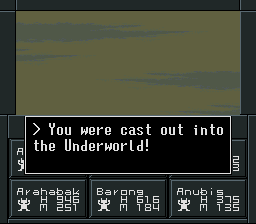
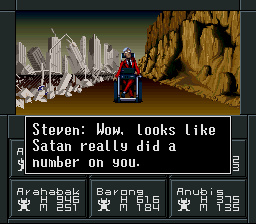
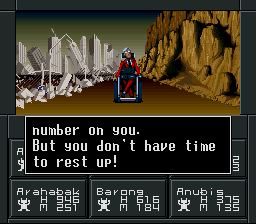
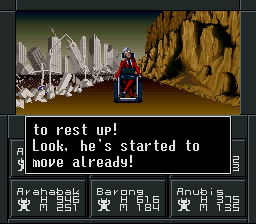
Space is the Place
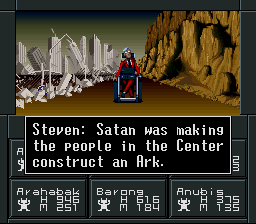
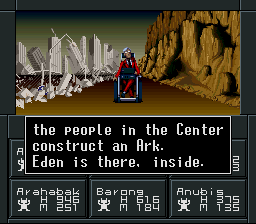
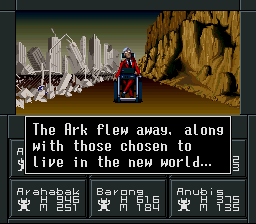
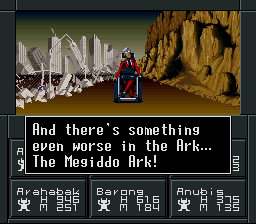
That sounds nasty.
Also: Xenogears, anyone?
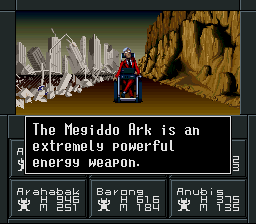
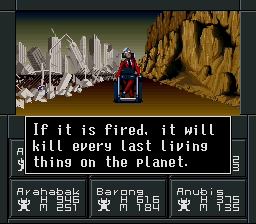
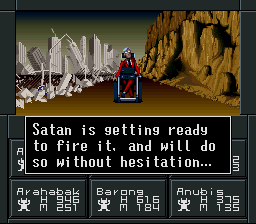
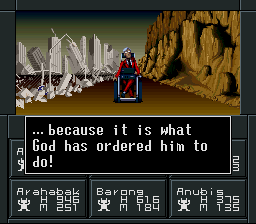
Well, that is bad.
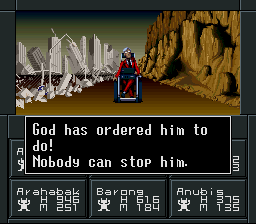
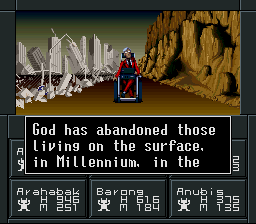
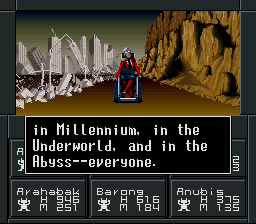
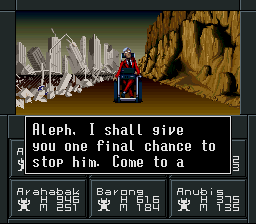
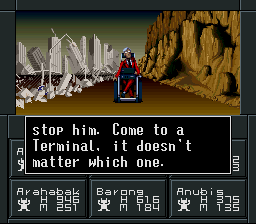
There are two options here. Do what Steven says, or walk all the way back to Binah for a 1 point increase in all stats.
Guess what the correct choice is.
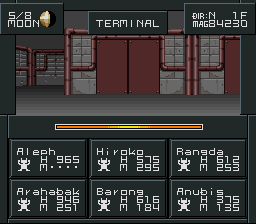
LAZYNESS.
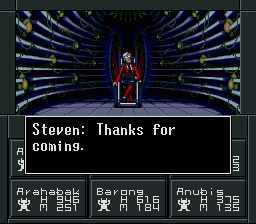
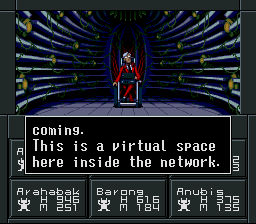
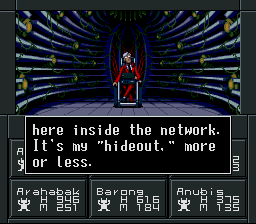
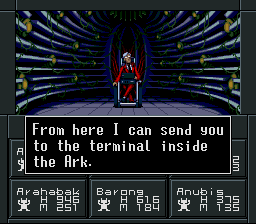
And he does. This is the point of no return.
There is no returning to the surface. Toraport and Toraest don't work. This is the last area.
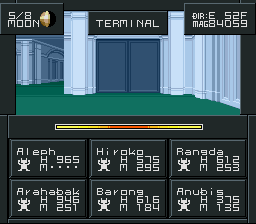
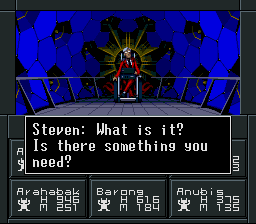
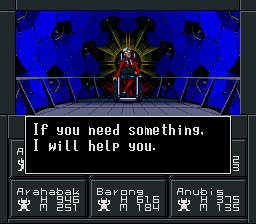
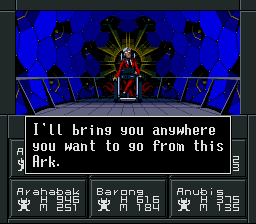
He lies.
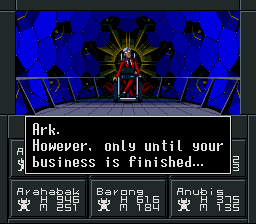
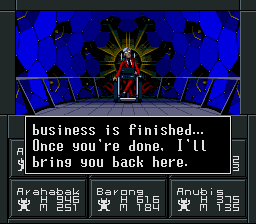
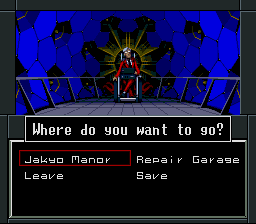
See? He does not bring you to Anoon's drug store. No other place sells the vital Hiranyas, the only item that can recover MP consistently
Muscle drinks can do it from time to time, but they are not reliable.
Okay, Somas CAN do it as well, but they are incredibly fucking rare.

ÏA! ÏA!
Wikipedia posted:
Cthulhu is a fictional being created by horror author H. P. Lovecraft, and is one of Lovecraft's Great Old Ones.[1] It is often cited for the extreme descriptions given of its appearance, size, and the abject terror that it invokes. Because of this reputation, Cthulhu is often referred to in science fiction and fantasy circles as a tongue-in-cheek shorthand for extreme horror or evil.
Cthulhu has also been spelled Kutulu, Q'thulu, Ktulu, Cthulu, Kthulhut, Kulhu, Thu Thu, Tulu,[2] and in many other ways. It is often preceded by the epithet Great, Dead, or Dread.
Lovecraft transcribed the pronunciation of Cthulhu as "Khlûl'hloo" or "Kathooloo"[3] S. T. Joshi points out, however, that Lovecraft gave several differing pronunciations on different occasions.[4] According to Lovecraft, this is merely the closest that the human vocal apparatus can come to reproducing the syllables of an alien language.[5]
Cthulhu first appeared in the short story "The Call of Cthulhu" (1928)—though it makes minor appearances in a few other Lovecraft works.[6] August Derleth used the creature's name to identify the system of lore employed by Lovecraft and his literary successors, the Cthulhu Mythos.
The most detailed descriptions of Cthulhu in "The Call of Cthulhu" are based on statues of the creature. One, constructed by an artist after a series of baleful dreams, is said to have "yielded simultaneous pictures of an octopus, a dragon, and a human caricature.... A pulpy, tentacled head surmounted a grotesque and scaly body with rudimentary wings."[7] Another, recovered by police from a raid on a murderous cult, "represented a monster of vaguely anthropoid outline, but with an octopus-like head whose face was a mass of feelers, a scaly, rubbery-looking body, prodigious claws on hind and fore feet, and long, narrow wings behind."[8]
When the creature finally appears in the story, it's said that the "Thing cannot be described", but it is called "the green, sticky spawn of the stars", with "flabby claws" and an "awful squid-head with writhing feelers". The phrase "a mountain walked or stumbled" gives a sense of the creature's scale.[9]
Cthulhu is depicted as having a worldwide cult centered in Arabia, with followers in regions as far-flung as Greenland, Louisiana, and New Zealand.[10] There are leaders of the cult "in the mountains of China" who are said to be immortal. Cthulhu is described by some of these cultists as the "great priest" of "the Great Old Ones who lived ages before there were any men, and who came to the young world out of the sky."[11]
The cult is noted for chanting its horrid phrase or ritual: "Ph'nglui mglw'nafh Cthulhu R'lyeh wgah'nagl fhtagn", which translates as "In his house at R'lyeh dead Cthulhu waits dreaming."[12] This is often shortened to "Cthulhu fhtagn", which might possibly mean "Cthulhu waits", "Cthulhu dreams".[13], or "Cthulhu waits dreaming" [14] Ostensibly part of a couplet from the Necronomicon, the other line being "yet He shall rise and His kingdom shall cover the Earth."
One cultist, known as Old Castro, provides the most elaborate information given in Lovecraft's fiction about Cthulhu. The Great Old Ones, according to Castro, had come from the stars to rule the world in ages past.“ They were not composed altogether of flesh and blood. They had shape...but that shape was not made of matter. When the stars were right, They could plunge from world to world through the sky; but when the stars were wrong, They could not live. But although They no longer lived, They would never really die. They all lay in stone houses in Their great city of R'lyeh, preserved by the spells of mighty Cthulhu for a glorious resurrection when the stars and the earth might once more be ready for them.[15] ”
Castro points to the "much-discussed couplet" from Abdul Alhazred's Necronomicon:
That is not dead which can eternal lie.
And with strange aeons even death may die.[16]
Castro explains the role of the Cthulhu Cult: When the stars have come right for the Great Old Ones, "some force from outside must serve to liberate their bodies. The spells that preserved Them intact likewise prevented them from making an initial move."[15] At the proper time,“ the secret priests would take great Cthulhu from His tomb to revive His subjects and resume His rule of earth....Then mankind would have become as the Great Old Ones; free and wild and beyond good and evil, with laws and morals thrown aside and all men shouting and killing and revelling in joy. Then the liberated Old Ones would teach them new ways to shout and kill and revel and enjoy themselves, and all the earth would flame with a holocaust of ecstasy and freedom.[17] ”
Castro reports that the Great Old Ones are telepathic and "knew all that was occurring in the universe". They were able to communicate with the first humans by "moulding their dreams", thus establishing the Cthulhu Cult, but after R'lyeh had sunk beneath the waves, "the deep waters, full of the one primal mystery through which not even thought can pass, had cut off the spectral intercourse."[18]
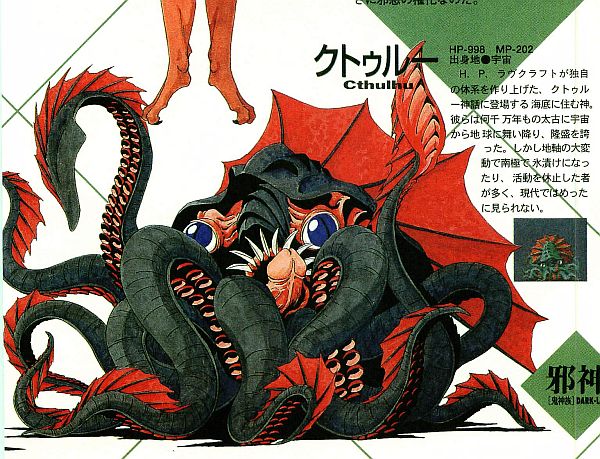
Yes. THat is a penis.

Lawful. LAWFUL.
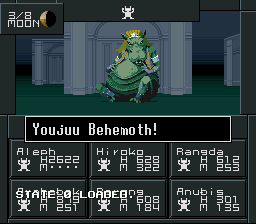
a behemoth!
Wikipedia posted:
Behemoth is a creature mentioned in the Book of Job, 40:15-24. In Hebrew it can be rendered as בהמות, Bəhēmôth, Behemot, B'hemot; in Arabic بهيموث (Bahīmūth) or بهموت (Bahamūt) .
The word is most likely a plural form of בהמה (bəhēmāh), meaning beast or large animal. It may be an example of pluralis excellentiae, a Hebrew method of expressing greatness by pluralizing a noun; it thus indicates that Behemoth is the largest and most powerful animal.
Metaphorically, the name has come to be used for any extremely large or powerful entity.
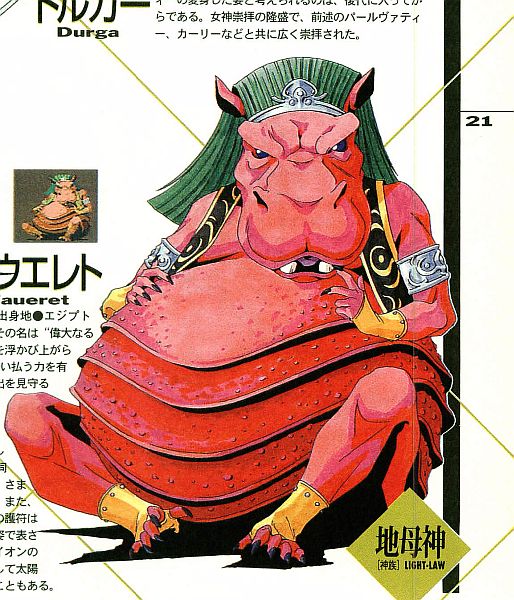
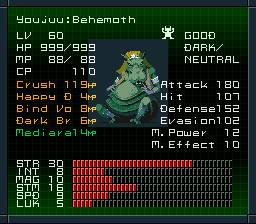
Everything has 999 around here.
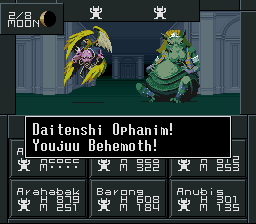
Wikipedia posted:
An Ophan (plural Ophanin, Ophannin, Ophanim) is one of a class of celestial beings described in the Book of Enoch[1] with the Cherubim and Seraphim as never sleeping, but watching (or guarding) the throne of God.
The word ophan means "wheel" in Hebrew so the Ophanim have been associated with the description in Ezekiel 1:15-21 and possibly again in the Daniel 7:9 (mentioned as gagal, traditionally "the wheels of gagallin", in "fiery flame" and "burning fire") of the four, eye-covered wheels (each composed of two intersecting wheels), that move next to the winged Cherubim, beneath the throne of God. The four wheels move with the Cherubim because the spirit of the Cherubim is in them. These are also referred to as the "many-eyed ones" in the Second Book of Enoch[2].
The Ophanim are also equated as the "Thrones", associated with the "Wheels", in the vision of Daniel 7:9 (Old Testament). They are the carriers of the throne of God, hence the name. However, they appear not to be the same Thrones (Gr. thronos) mentioned by Paul of Tarsus in Colossians 1:16 (New Testament).
These Angelic Princes are often also called "Ophanim, Wheels or Galgallin." It is said that they were the actual wheels of the Lord's Heavenly Chariot (Merkabah). "The four wheels had rims and they had spokes, and their rims were full of eyes round about." They are also frequently referred to as "many-eyed ones."
Gulley (1996: p.37) states that:
The 'thrones'; also known as 'ophanim' (offanim) and 'galgallin', are creatures that function as the actual chariots of God driven by the cherubs. They are characterized by peace and submission; God rests upon them. Thrones are depicted as great wheels containing many eyes, and reside in the area of the cosmos where material form begins to take shape. They chant glorias to God and remain forever in his presence. They mete out divine justice and maintain the cosmic harmony of all universal laws.
Having the most bizarre physical appearance of the celestial host, they are described as great wheels, covered with a great many eyes and glowing with light. One explanation given for this (besides them acting as God's chariot), is that they mark the end of the first Choir, where the emanations of God begin to take on more material forms and as such exist in a state of transition.
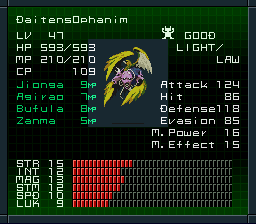
Low HP
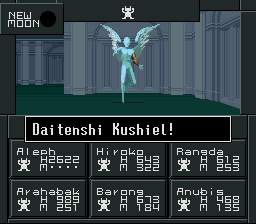
Wikipedia posted:
Kushiel "Rigid One of God" in Jewish Angelology is an angel involved with punishing individuals in Hell.[1]
Kushiel is one of seven angels of punishment in Jewish folklore along with Hutriel, Lahatiel, Makatiel, Pusiel (or Puriel), Rogziel and Shoftiel.[2]
As a "presiding angel of Hell," he is said to punish nations with a whip made of fire,[1] although, along with the other angels of punishment, is reported in 2Enoch 10:3 to dwell in the third heaven.[3]
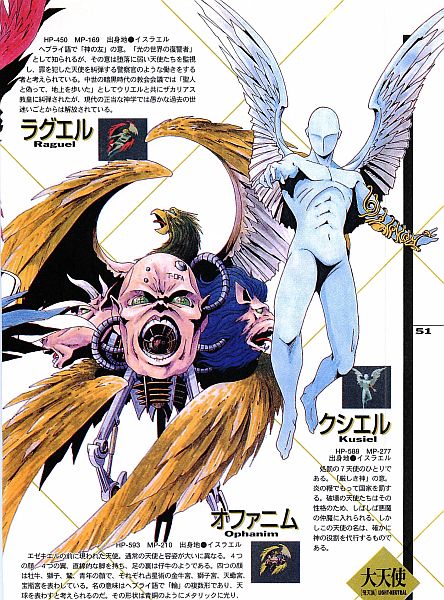
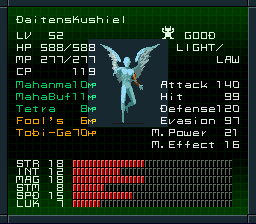
Obviously lawful. Recruited one.
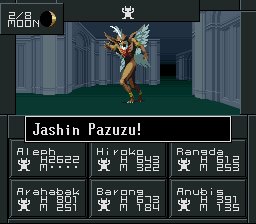
A SERPENTINE PENISWikipedia posted:
In Assyrian and Babylonian mythology, the god Pazuzu was the king of the demons of the wind, and son of the god Hanbi. He also represented the southwestern wind, the bearer of storms and drought.
Pazuzu is often depicted as a chimera of animal and human parts. He has the body of a man, the head of a lion or dog, eagle-like taloned feet, two pairs of wings, a scorpion's tail, and a serpentine penis. He is often depicted with his right hand pointing upwards and his left hand downwards, a gesture having a long-standing meaning in occult circles, i.e., "As Above, So Below."
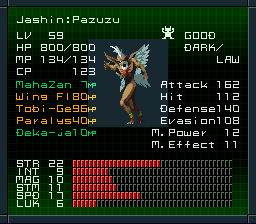
serpentine. PENIS.
And there were enough random encounters to raise Aleph to level 72.
The game is now FUCKED.
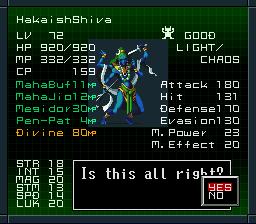
FUCKED I SAY.
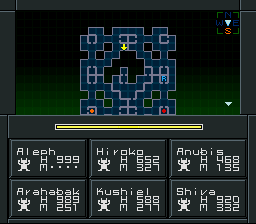
aS YOU will all see once Aleph and company cross this particular gate.
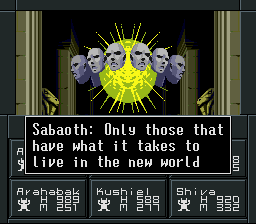

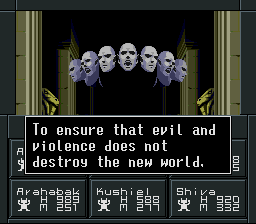
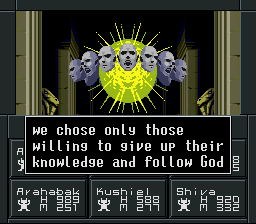
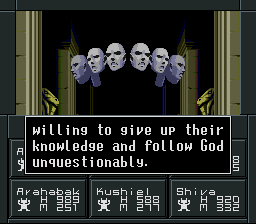
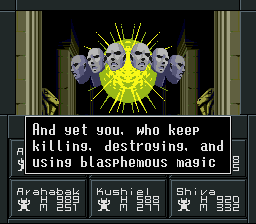
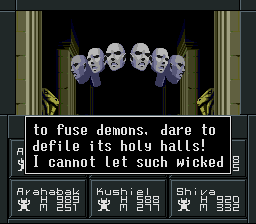
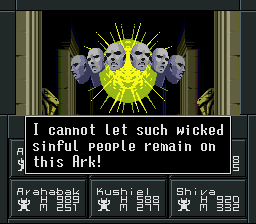
THEN DIE.
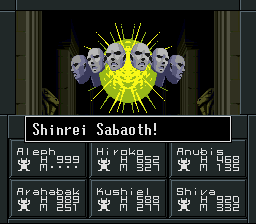
Wikipedia posted:
YHWH Tzevaot/Sabaoth
The name YHWH and the title Elohim frequently occur with the word tzevaot or sabaoth ("hosts" or "armies", Hebrew: צבאותas YHWH Elohe Tzevaot ("YHWH God of Hosts"), Elohe Tzevaot ("God of Hosts"), Adonai YHWH Tzevaot ("Lord YHWH of Hosts") or, most frequently, YHWH Tzevaot ("YHWH of Hosts"). This name is traditionally transliterated in Latin as Sabaoth, a form that will be more familiar to many English readers, as it was used in the King James Version of the Bible.
This compound divine name occurs chiefly in the prophetic literature and does not appear at all in the Pentateuch, Joshua or Judges. The original meaning of tzevaot may be found in 1 Samuel 17:45, where it is interpreted as denoting "the God of the armies of Israel". The word, apart from this special use, always means armies or hosts of men, as, for example, in Exodus 6:26, 7:4, 12:41, while the singular is used to designate the heavenly host.
The Latin spelling Sabaoth combined with the large, golden vine motif over the door on the Herodian Temple (built by the Idumean Herod the Great) led to identification by Romans with the god Sabazius. In Christianity this title is translated as "God of the Universe".[citation needed]
YHWH Tzevaot (file info) — play in browser (beta)
Problems listening to the file? See media help.
The name Sabaoth is also associated with a demi-god in the gnostic scriptures of the Nag Hammadi Text; he is the son of Yaltabaoth.
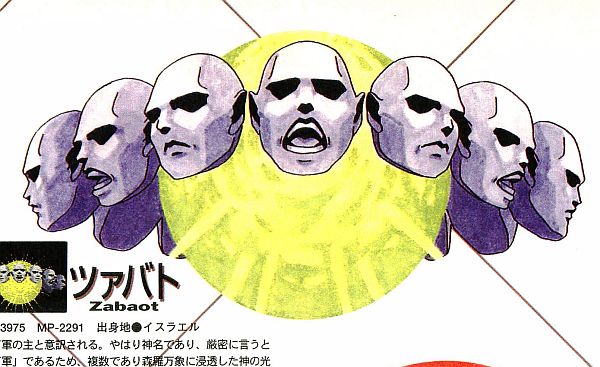
It does. It dies.
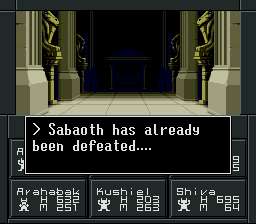
One of the names of God is DEAD.
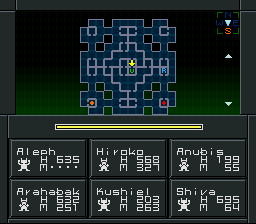
And whatever lies beyond that set of stairs, can wait for next time. Healing and stuff comes first.